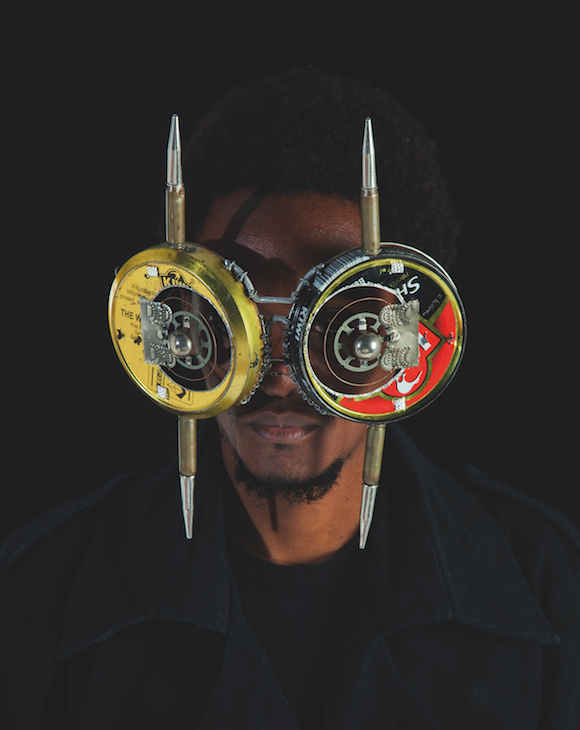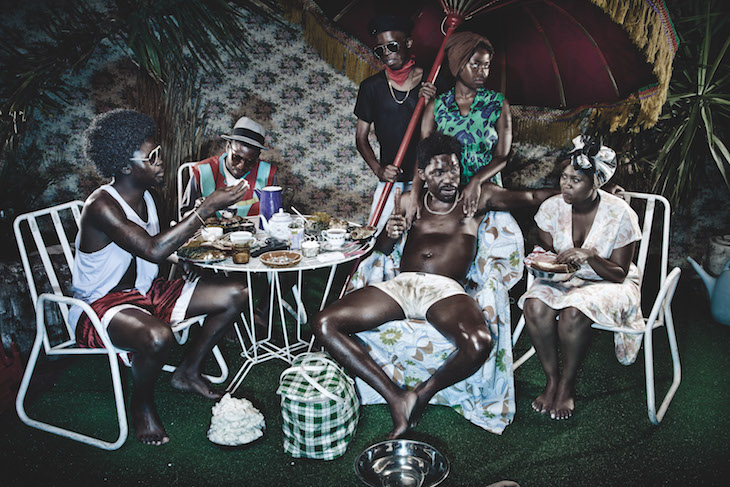The artist Vladimir Tretchikoff vividly described the Cape Town art scene as ‘riddled with bitchiness like a Gorgonzola with penicillin’. Forty years later little has changed. In the city and the country as a whole ‘there’s almost a tradition of museum bashing,’ says Mark Coetzee, director of the recently opened Zeitz MOCAA, the continent’s first major museum of contemporary African art.
If isolation under apartheid created an exclusionary and monopolistic culture – the populist Tretchikoff was a well-known victim of this – then today a very different yet equally exclusionary and isolationist force is at play under the treacherous pretext of ‘identity politics’. Why, many sceptics wonder, is the museum named after a German businessman – an objection that, in raising the spectre of neo-colonialism, fails to understand South Africa as a heterogeneous nation.
Macho Nne 05 (Westgate) (2014), Cyrus Kabiru. Zeitz MOCAA, Cape Town

Coetzee is understandably unconcerned by such inhibitive talk. ‘South Africans are notorious for destroying everything before them,’ he says, before pointing to the internationally celebrated Nigerian curator, Okwui Enwezor, who ‘was vilified for bringing international artists into the South African art scene’. With little interest in parochial naysayers, Coetzee firmly reminds us that Zeitz MOCAA is ‘an international institution which represents Africa to the world. It’s not a local Cape Town institution. It fulfils a mission much greater than Cape Town itself.’
Internationalism is the museum’s defining ethos. When Edson Chagas won the Golden Lion at the 2013 Venice Biennale for his installation of photographs of Luanda at the Angola Pavilion, Zeitz MOCAA’s acquisition committee bought the entire show with a view to ‘securing that seminal moment for an African institution’. Further purchases followed – Kudzanai Chiurai’s Documenta 13 show, Cyrus Kabiru’s ocular wire works, theblue paintings of Chris Ofili, and the film Ten Thousand Waves (2010) by Isaac Julien. When exhibited at MoMA, Julien’s nine-screen projection, according to Coetzee, was ‘the most visited contemporary art exhibition in the world. And Zeitz MOCAA owns that piece.’
Revelations VIII (2011), Kudzanai Chiurai. Zeitz MOCAA, Cape Town

It is clear, therefore, that Zeitz MOCAA is most preoccupied with embodying a diasporic African Esperanto or a cultural ethos which splices the local and the global. Modelled on the Guggenheim’s Bilbao and Tate Modern – both of which are based in port cities – Zeitz MOCAA seeks to overcome the country’s traditional North-South divide and has wholly embraced its liminal location between the East and the West, the Indian and Atlantic Oceans, and the many different cultures that meet in Cape Town.
Situated inside a converted grain silo – built in 1921 and redesigned by the British architect Thomas Heatherwick – Zeitz MOCAA also operates as a bridge between the past and the future; between an early industrial, steampunk aesthetic and the clinical late modern austerity one associates with the white cube. This design overlay is strikingly apparent, and the creators of the museum were adamant that the building should only be understood once entered. ‘It’s an “inny” rather than an “outy”,’ says Heatherwick. ‘You can’t say you’ve seen the project unless you’ve been inside.’
This view implicitly challenges the now-waning rage for beguiling and distracting exteriors created by ‘starchitects’ such as Frank Gehry. Heatherwick has designed an aniconic and romantic building that integrates and warms the many who, historically, have been isolated from the art world. With its pop-eyed windows, like blown glass, the building seems to breathe. This aerated quality is further underscored by its bisected tubular interior, suggesting the lungs of a giant church organ. ‘When you walk in, and you see the physicality of it, immediately you get it,’ Coetzee says. ‘There’s enough space for enough variants and enough viewpoints.’
View of the interior of Zeitz MOCAA, designed by Thomas Heatherwick Studio. Photo: Iwan Baan

For Coetzee, it is the building’s immersive and democratic capabilities that drives this forward-looking project. What distinguishes Zeitz MOCAA as an idea and an ethos is a worldliness that places Africa at its epicentre. ‘Do we as an arts community want to be progressive, do we want to look forward? Or do we want to maintain the status quo?’ Coetzee’s question is telling, for what impels this major initiative is the desire to create a progressive vision of Africa’s ever-changing moment.
‘As South Africans we want more,’ he says. ‘I think we want to look beyond our borders – and I think that’s the role that the museum is going to play.’ ‘We have to educate ourselves to be more open-minded, to be less prescriptive, to be less localised, to understand that there are conversations that we’re not even a part of because we’re so rigid in hatred, in our decolonising project, our identity politics.’
The museum is unconcerned by Africa’s historic abjection, and focused more scrupulously on the present. This allows it to reconfigure suffering, invoke wonder, and redefine the continent’s intellectual history. Zeitz MOCAA is, in effect, a subjunctive enterprise – it wills a different and more enabling future in which Africa, finally, assumes its pivotal place within the global art world.
All too aware of the buzz surrounding African art today, Coetzee has chosen not so much to deflect its fashionable status but to challenge it. By purchasing in depth from across Africa – with the understanding that an artist is best grasped when presented through a greater corpus – Coetzee hopes to deepen our understanding of the significance of a given artist and his or her place within a greater world.
As Matthias Leridon, who runs AAD, the African Artists for Development foundation, notes: ‘As the biggest institution on contemporary art in Africa, Zeitz MOCAA will effectively become the flag for African art and with this comes great responsibility and challenges.’ Such an initiative requires a high level of curation, for ‘the museum can play a huge role in the perception of the continent by leap-frogging cliched perceptions of Africa. ‘It is important that African people create and drive their own African narratives,’ Leridon concludes. ‘Ambition creates duty.’
Zeitz MOCAA opened in Cape Town on 22 September.
From the October 2017 issue of Apollo: preview and subscribe here.



